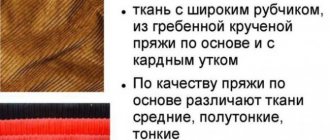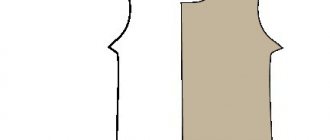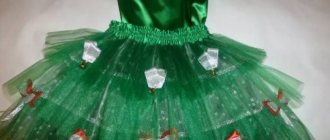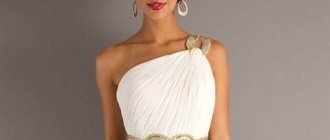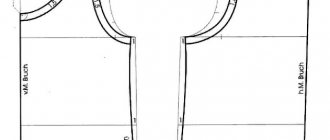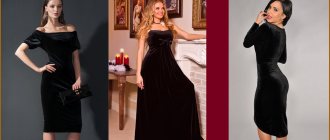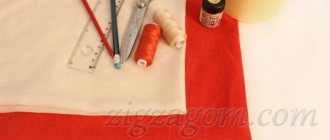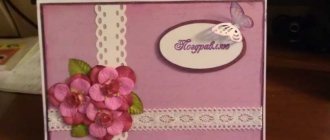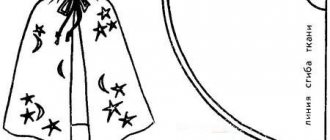A sundress is one of the most comfortable, practical outfits for girls. Summer, flared, double-sided, school, with a pleated skirt, warm, combined with openwork inserts, for babies and almost adult girls - there are a lot of model options. Sewing a sundress allows you to show your imagination and does not require deep knowledge, modeling and sewing experience. The patterns for these products are usually very simple. And sometimes you can do without them altogether. Now we will look at how to sew a sundress for a girl.
Sundress with contrasting trim
Patterns for a child:
- 1 year;
- 2 years;
- 4 years;
- 6 years;
- 8 years
- 10 years;
- 12 years old;
- 14 years old.
This is interesting: Sundress pattern for girls (size 6 months-4 years)
A simple model for a girl for a year
A light summer sundress with a minimum of details is an excellent option for beginners. Sewing it will take a minimum of time; it does not require additional decor. This is a beautiful model in which a girl will be comfortable.
The pattern is based on a trapezoid measuring 8 cm at the top edge, 22 cm at the bottom, and 21 cm in length. All that needs to be modified in the trapezoid to form armholes is to step back 6 cm from the sides and smoothly bring the lines to the side edges of the trapezoid.
Having cut out 2 parts of the base, they are folded face to face, then the side sections are ground off and processed on a machine. Having ironed the bottom seam allowance, a finishing braid is pinned to it. It is sewn on, the edge is overcast, then folded so that the braid is visible, and a finishing stitch is applied.
Armholes can be finished using bias tape. To prevent them from looking stretched when finished, when processing you need to slightly stretch the bias tape and make a barely noticeable wave of textiles. For convenience, it is better to use sewing pins. This results in a wide border on the reverse side.
A caveat: bias tape may seem capricious to a beginner. To make sewing a sundress evoke pleasant emotions, and not have to bother with the trim, you can change the processing of the edge of the armholes. To do this, you first need to iron the finished bias tape, folding it in half. It is much easier to sew it on with one line, putting the edge of the armhole inside.
Now all that remains is to fold the top edge of the sundress, stitch it and insert a satin ribbon. Fashionable new clothes for your daughter are ready!
LiveInternetLiveInternet
Quantum Transition of Consciousness
There is nothing stronger than an idea whose time has come
A few will wake up a few, a few will wake up many, many will wake up everyone
Today, unprecedented civilizational changes are taking place throughout the world. Without exaggeration, we are witnessing the beginning of a new era in the history of mankind. “Quantum Transition”, “global awakening of consciousness”, “vibrational transformation”, “ascension of the Earth” - today many are not only familiar with these concepts by hearsay, but are already actively and consciously involved in the ongoing processes.
Now even people far from esotericism and spiritual quests understand that humanity is in an acute phase of a civilizational crisis and for our continued existence on the planet, radical transformations are necessary in literally all spheres of society. At the same time, it is quite obvious that, first of all, changes are necessary in the consciousness of every person. In fact, we are talking about a quantum leap in the development of human consciousness. This is precisely the essence of the fundamental changes that await humanity with the advent of a new era.
In cosmic cycles, the vibrational transformation of the planet and all of humanity is directly related to the Age of Aquarius, which has already arrived.
The concept of the Age of Aquarius, abstract at first glance, has a very specific astronomical context. The solar system is continuously moving in our Milky Way galaxy, the energy structure of which is heterogeneous, and is now moving from the region dominated by low-frequency radiation to the zone of high-frequency fields. The impact of high-vibration energies of the Universe inevitably affects in the most radical way both the Sun and the Earth, and even more so on people.
At the physical level, numerous signs of global transformation are already observed: an increase in the Schumann frequency, registration of anomalous cosmic phenomena, global climate change, an increase in the number of natural disasters and catastrophes, etc.
The Quantum Transition is not so much an evolution of reality, but an evolution of the perception of reality and an evolution of self-awareness. Changing reality itself is a consequence. It is necessary to clearly understand that all the changes that occur primarily consist in the transformation of human consciousness, namely in increasing awareness with a multiple expansion of perception. Therefore, the awakened people of the new era will begin to perceive as a matter of course not only the familiar dense material physical world, but also other levels and layers of reality inaccessible to the five senses, which are now seen by only a few - shamans, psychics and the like.
For thousands of years, sacred knowledge about the true nature of reality, about the relationship between man and God remained the privilege of a narrow circle of initiates. They were passed down from generation to generation to chosen successors and were strictly guarded. Now the time has come for the disclosure of such information: true knowledge is penetrating massively into the public consciousness through numerous channels and becoming available to all seekers. In itself, such information support further catalyzes the process of transformation of consciousness.
Initiates of various spiritual and occult movements are well aware of the reasons for the ongoing explosion of revelations. Thus, Kabbalists directly connect the coming Quantum Transition with the time when secret knowledge about the “cause-and-effect relationships of the universe” will be revealed to the peoples of the world, and a person “will know the true meaning of life and will be able to identify himself with eternity” [, ]. The holy book of Kabbalah, Zohar, says: “All heavenly treasures and secrets, the solution of which many generations have struggled with, will be found and solved in the Age of Aquarius.” It is also indicated that the people of the Age of Aquarius will use phenomena that not only did not exist before, but which could not even be imagined [117].
Christian prophecies directly speak of the end of “this world” and the onset of a new era: “When the invisible world becomes visible,” “we expect a new heaven and a new earth in which righteousness dwells,” “may God be all in all,” “in that day there will be One God, and His Name will be One” [, , , ].
Modern philosophy calls this quantum leap in the development of earthly civilization an anthropological turn, which, according to the calculations of initiates, should take place in the middle of the 21st century. According to the calculations of Isaac Newton (a famous alchemist and theologian of his time), this turn (“the end of this age”) will occur no later than 2060. According to the interpretation of the Book of the Prophet Daniel - in 2040. And according to the traditional Chinese cyclical calendar, “Sali” is exactly in 2044 [, ].
It is obvious that the process of such global changes will be non-linear and will extend over time. In different parts of the Earth, transformation will occur at different speeds and intensity. The transition period has already begun and will last until its full completion in the middle of the 21st century.
The One Consciousness is everything. This is the immutable truth that was previously directly accessible only to a few enlightened ones, and in the coming era will be a key prerequisite for humanity and will begin to determine the nature of relationships in all spheres of human life. The deep and total awareness that all people are only emanations and temporary incarnations of the Unified Consciousness, through which this single higher “I” perceives and lives all the diversity of manifestations of life, will literally change all social, economic, political and spiritual processes in human society. The indigo people, awakened, will become the hegemon of the new era society.
Therefore, the main task of the Quantum Transition is precisely the awakening of the individual consciousness of each person, followed by complete and unconditional identification of oneself with the Unified Consciousness of the Universe. It is necessary to realize oneself as the One (or the Absolute), who has deliberately forgotten his essence, in order to play the role of an ordinary person and thereby gain the experience of corresponding experiences.
THE COMING OF A NEW ERA MEANS THAT IT IS TIME TO REMEMBER YOUR TRUE SELF AND MOVE TO A NEW LEVEL OF EVOLUTION OF CONSCIOUSNESS IN ORDER TO PARTICIPATE IN THE CREATION OF REALITY WITH A COMPLETELY DIFFERENT DEGREE OF CONSCIOUSNESS.
The essence of awakening consciousness is precisely this - to realize your true nature. Remember that you are not a person, not a person as an object, but awareness itself. Here awareness is meant as a process, as the perception of a flow of experiences. This is exactly the state that corresponds to achieving enlightenment in Buddhist practice.
Remembering your true self means parting with the illusion of the existence of a separate personality, a “little “I” [182]. In the highest sense, “I AM EVERYTHING” means to realize that you are triune: at the same time THAT that looks, and awareness, and the very space in which all this happens.
In such a state of consciousness, knowing everything about everything is not a paranormal superpower and is perceived as something completely logical and natural. Free access to true knowledge and any information is not the only thing that awaits the awakened part of humanity. As mentioned earlier, for people who have fully transitioned into a new era, the usual boundaries between life and death will disappear, individual consciousness will begin to directly identify itself with the Unified Consciousness of the Universe, infinite and eternal. Subsequently, for those who are fully awakened and have moved to a new level of perception, such “superpowers” as levitation, teleportation, telekinesis, materialization, free energy, telepathy, instant healing, etc. will be natural. Such siddhis will be activated in people everywhere. At first, this process will be of a targeted nature, but will gradually become all-encompassing. In the reality of the familiar world, the features of a new era will begin to appear more and more, which will not be able to be hidden or ignored. The “miracles” happening everywhere and literally before our eyes will involuntarily force you to wake up and reconsider your picture of the world, push you to rethink life values and intensify personal changes.
The Quantum Transition provides truly unique opportunities for people living today. For any person, this is a kind of springboard that allows you to awaken, realize your true self and make a leap in the evolution of consciousness. The vibrations of the Quantum Transition provide a rare chance to rise almost instantly (by universal standards) in one’s development on the “crest of the moving wave.” But this same wave can also bury those who are slowing down in their spiritual evolution. The ongoing global transformation will not automatically awaken absolutely all people. Figuratively speaking, the Quantum Transition will create favorable “weather conditions” and “prepare the ground” for the transformation of consciousness, but in order to “sow the seeds” and cultivate awareness, each person must make his own personal efforts.
The Quantum Transition to a new reality implies radical transformations in the consciousness of every person. These transformations are associated with an inevitable change in people’s worldview and, as a consequence, with a total change in lifestyle.
The basis of the coming changes is the deep awareness that everything that exists around - people, animals, all nature - is YOU! Comprehension of this fact, repressed by the ego-mind, naturally gives rise to an attitude towards everything that exists as towards oneself. The well-known Christian principle - “love your neighbor as yourself” - speaks precisely about this. All that exists is YOU. One Unified Consciousness. There is nothing and no one here except you. EVERYTHING is a manifestation and embodiment of you.
All dividing ideologies existing in the world today - nationalist, religious, class - are becoming a thing of the past. In this sense, the ideology of modern times is unifying - supranational and supraconfessional, because it fully corresponds to the biblical principle “there is neither Greek nor Jew.” Division and keeping in the dark were the main methods of manipulative control of a bygone era. The time has come for people to unite , and at the level of their original true nature.
From the realization that “I am EVERYTHING” will begin to flow the nature of people’s relationships in the near future. All social interactions will begin to be built on the basis of the well-known principle: “the more you give, the more you receive.” It is this model of relationships that will completely determine the life of people of the new era. In the conditions of modern times, this principle acquires unprecedented relevance, because The effect of the “boomerang of goodness” or “karmic retribution” begins to operate with particular force. In some cases, the “sow and receive” mechanism will work almost instantly.
The one consciousness is everything. For this reason, when you give to another person, you give to yourself; when you do something for another person, you do for yourself. Thanks to the deep awareness of this fact by more and more people, the principle of “creating” and “giving”, and not “taking” and “consuming” in the coming era will become a spiritual law, the essence of which is “ to rejoice in the fact that the person next to you is happy.” " Therefore, the highest and unconditional values will be: all manifestations of love, service, mutual assistance, participation, empathy, generosity, selflessness, care for others, harmonious coexistence with nature.
With the advent of a new era, the time comes for the embodiment of that very model of human relations, long ago predicted by famous prophets, when “every person will live for the sake of his neighbor,” thanks to which “humanity will form a United Spiritual Brotherhood,” and in the economy “socialism will return in a new form.”
Giving to get more is an old principle that works flawlessly. Even people who are at the initial stages of spiritual development and have not yet developed sincere altruism, generosity and selflessness can successfully use it. This will be, to a certain extent, highly conscious egoism, when personal goals, be it money, health, relationships, etc., are achieved not directly “head-on” - by pushing through space and snatching what they want from other people, but by sowing karmic seeds. The old approach “he who has the knife, the one with the meat” in the reality of modern times is working less and less and will soon cease to work at all. Business for profit and making money as a measure of success are becoming the lot of a passing era. From now on, running a successful business is possible only if the company sincerely fulfills its mission and adheres to social responsibility.
Thus, for people who find it difficult to suddenly change their old values and way of thinking - to live solely for themselves - in the initial stages of transformation of consciousness they will have to adhere to the principle of conscious egoism. Until you develop an automatic habit of investing in the people around you and giving back with joy - only this will allow you to remain successful in the realities of the new time. Even if selfless giving and the creation of good in itself does not give due pleasure, it must be done as a “karmic investment”, clearly knowing that by giving, you are absolutely guaranteed to receive many times more. For this reason, there is a custom among Buddhists to thank those who turned to them for help and whom they were able to help, because this person thereby provided the opportunity to launch the next “boomerang of goodness” (to do “karmic sowing”).
To create, create, give and invest with sincere joy in the people around you - the embodiment of these principles in social relations is highly consistent with the ongoing global transformation of consciousness. The implementation of this model of human relations is a life-saving, life-affirming development option for our civilization. Following this particular principle will allow humanity to unite at its original level and safely overcome all the challenges and crises of our time, incl. avoid scenarios of an electronic concentration camp and purge of the population in the concept of the “golden billion” in order to ultimately move into a qualitatively new state. Make a Quantum Transition of consciousness.
Summer model for 2 years: master class for beginners
A mother who has an hour of free time can sew a cute sundress with straps for her daughter. Even a beginner can cope with sewing such a model. In addition, the measurements for the pattern are also minimal: you need the bust circumference and desired length.
Cutting details
The pattern is designed for a 2 year old girl. Having measured the circumference of the chest, add a small allowance for loose fitting, then divide the result by 2. The length of the bodice depends on preference. The approximate figure is 30 cm.
The top of the sundress will be double. Cut from fabric:
- 4 rectangles 16 x 30 cm (bodice), then the upper corners are beveled in a straight line by 5 - 7 cm, forming armholes.
- For the skirt, cut out 2 rectangles measuring 33 x 50.
- The straps are cut out 3 cm wide, the length depends on the individual child.
When cutting, it is worth considering a small nuance: without an allowance for a loose fit, putting on a sundress can cause difficulties.
Sewing technology
It's pretty simple:
- first prepare the straps by sewing them on a machine;
- The bodice parts are connected in pairs with right sides facing inward;
- Having outlined the correct position of the straps (at the very top corner of the armholes), they are placed between the paired parts of the bodice;
- the top blanks are stitched on three sides without touching the bottom cut, then turned right side out and ironed;
- the skirt parts are folded with the right sides inward, sewn down on the sides and the seams are processed using an overlocker;
- A narrow lace ribbon is sewn to the bottom edge, then the allowance is overcast and secured with a finishing stitch.
- Having aligned the skirt with the side seams, find the centers of the front and back;
- folds are laid from the centers of the skirt, distributing them symmetrically on both sides (for convenience, it is better to pin together the centers of the parts and the side seams of the top and bottom);
- the skirt is connected to the bodice, the edge is overcast (if desired, you can fold the seam allowance to the side of the bodice and secure it with a stitch).
The straps are tied when putting on the product. If the model seems rustic, you can decorate it with a small flower along the line where the bodice and skirt meet.
Sew a school sundress
2.1. First of all, we prepare the skirt. It is necessary to lay folds from the center of the skirt along the notches that we made on the top and bottom of the skirt panel. The folds are placed towards the side seams. Secure them with pins.
2.2. We set the maximum seam on the machine and sew the skirt along the waist and bottom (the widest and narrowest sides).
2.3. We smooth them out with an iron. And let the fabric cool on the ironing board. (We will unravel the bottom line later; it is necessary to make it easier for us to smooth out the folds).
Top assembly
3.1. Now we take the two main parts of the back and overlock the places where the hidden snake is sewn (the center of the back).
3.2. We put a one-sided foot and sew a snake on top on the left half of the back.
Then to the right.
3.3. Then we connect the waist seam of the back with the skirt (the narrowest part with the folds) and sew a finishing seam along the upper part onto the foot.
3.4. We also connect the front front and the skirt. We overlock the side seams and the bottom of the skirt. Treatment sites are shown with a red line.
3.5. Sew the front and back of the face to the face along the side and shoulder seams. The preparation of the top is completed.
3.6. Now let's move on to the facing. Sew it along the shoulder and side seams.
The bottom needs to be overlocked.
3.7. We connect the neck of the sundress and the facings together, stitch it on a machine, notch it from the inside and set it off by 0.1 mm for better laying out of the neck.
3.8. Now you need to connect the facing and the top along the armhole (where you stick your hand). To do this, fold them together in the area of the shoulder seam (the narrowest place), and then turn the edges away from you, it is better to secure the result with a pin.
Be sure to hold the edges when sewing so that the fabric does not move away.
3.9. So we sewed one side
Now we sew the opposite part of the first armhole without turning, simply connecting the edges.
Make the second armhole in exactly the same way and notch the inner edges of the seam.
3.10. Sew a finishing line 0.1 along the facing around the armhole, as on the neckline, as far as the presser foot allows. Trying to stitch completely in a circular pattern will not work, the place in the shoulder seam is too narrow
3.11. Close the snake by sewing the facing to the back
3.12. Hem the bottom along the hem (dotted line on the pattern).
3.13. Fold the belt in half. When finished, the width of the belt is 2 cm. Sew along the entire length, turn it inside out and press it. Sew a buckle onto the open end. Make belt tacks at the folds of the skirt and side seams. Fasten the end of the belt through the buckle.
The school sundress is ready!
You can download our pattern at the beginning of the article in the archive, print it and use it for yourself.
For a better understanding of the assembly of the pattern, a general view of the assembly of the scanned parts is attached.
Good luck to you!
Author of the article: Nitashi Eraklier
Sewing and photographs: Workshop MY CODe. Groups in and
How to sew a children's sundress - instructions
Many novice seamstresses, due to the lack of a pattern, decide to go to the store and buy a new sundress for their daughter, rather than sew it themselves. But making a pattern is not a difficult task at all. Naturally, it’s impossible to find ideal patterns for different body types, but any mother can build a pattern based on her own measurements. Even for a sundress like the one shown below in the image.
Lush sundress
Construction of a pattern diagram
This model is suitable for girls from two to eight years of age. It is better to choose fabric made from natural fibers if you want to sew a sundress for the summer. Satin, chintz, silk, etc. are perfect. The colors are also selected individually to suit the child’s color type.
To build a diagram, you will need to take measurements:
- Half chest girth - PoG
- Half waist circumference - PoT
- Half neck circumference - PoSh
- Sundress lengths - DS
- Shoulder length - DP
- Length from shoulder to waist - DPT
Below is a diagram of the sundress pattern. The product can be sewn with or without pockets, sleeves. Next, we will consider a model without pockets or sleeves.
- Start building the diagram with the back part . To do this, draw a quadrilateral. Down from the point, set the length of the product from the shoulder to the waist. Set aside 1/2 PoH to the right side - build auxiliary lines in the form of a rectangle, then set aside 1/4 PoH from the top point of the rectangle, 7.2 is the length of the shoulder. Set aside 3.9 cm down from the resulting point to get a shoulder bevel and connect the points with an even line.
- According to your own standards, design 1/2 of the front part . Where 12.7 is 1/2 PoG, 5.7 is 1/2 PoSh, 7.2 is the length of the shoulder. And also cut out the lower part of the front. Where 14.7 is 1/2 PoG, and 11.7 + 4.5 = 1/2 PoT.
- After this, you can move on to cutting a full skirt for a sundress. It is presented in the figure as a quarter circle. 16.3 is PoT + 1 cm, 26.5 is the length of the sundress skirt.
Sundress for a little fashionista
You will also need to cut out bias tapes for finishing the neckline and armhole.
Instructions for sewing the product:
You will need tools and materials:
- Material for sewing the product - take the length of the product plus 15 centimeters
- Scissors, sewing machine, thread
- Satin fabric for the belt, snake.
Work process:
- Begin the process by transferring the pattern from paper to a fabric surface. Try to arrange the cut details sparingly so as not to waste material.
- When you draw the details of the sundress on the fabric, be sure to allow seam allowances, otherwise the item may turn out to be too tight for the child.
- Make sure that you have transferred everything onto the canvas correctly, only then cut out the parts of the sundress with scissors.
- The first thing to do is sew the top and bottom of the front.
- Then baste the zipper on the side seam, and sew the side parts of the front and back. Also sew the shoulder sections and overlock the edges of the product to prevent fraying.
- Sew the circle skirt in the waist area with a large stitch and slightly gather the seam so that it matches the size of the front and back.
- Sew the skirt to the top of the garment. Again, finish the seams with an overlocker, let the child try on the sundress, if everything fits in size, start processing the top, armhole and hem the bottom of the skirt.
- Make a ribbon from satin, and in the middle, so that the belt holds its shape, you can insert dubbing, etc.
The sundress is ready, in this outfit you can go for walks and to kindergarten. Below, look at patterns of sundresses that are suitable for school and everyday wear.
Sundress for a schoolgirl
Lush sundress
How to sew a school uniform for a girl yourself
Advantages of custom tailoring of school clothes
An individual approach to creating a wardrobe will always have advantages over purchasing clothes in stores.
The same applies to school uniforms. Why is it better to sew clothes for school yourself:
- The quality of school uniform tailoring will be higher. You don’t have to think about the fact that within a week the seams will come apart or the lining will tear.
- Self-tailoring allows you to choose any fabric you like, because often clothes that fit the style are made from fabric with a high synthetic content.
- The school uniform will fit perfectly. You can choose the optimal length and width of the item.
- Hand-sewn clothes are cheaper than those bought in a store or ordered from a tailor.
- A school uniform made independently will be one of a kind. Thanks to this, the girl who wears it will always be able to stand out from the crowd of children.
How to sew a school sundress with your own hands
To ensure that self-sewn clothes are not inferior in quality to expensive factory items, there is no need to rush, but, on the contrary, you should adhere to the established sequence of actions. Free patterns that can be downloaded on the Internet will help even an inexperienced dressmaker learn how to sew. You need to start simple. For example, you can sew a school sundress for a 7-10 year old girl.
- Download the pattern on a reduced scale, and using the indicated dimensions, repeat it on paper in the original size. Or take measurements yourself and follow the suggested sequence of actions to make a pattern with your own hands.
- Transfer the pattern to the fabric and cut it out, remembering to leave a seam allowance of 1-1.5 cm on each side.
- Sew all the details of the sundress: connect the side seams of the bodice to the back, then the shoulder seams.
- Press all seams towards the center. The sides and bottom of the skirt can be processed immediately, and the shoulders only after the armhole and neckline are finished, which are trimmed with facings.
- The downloaded pattern must be accompanied by a detailed description of sewing the selected sundress model, which should be followed while working.
New look style for 8 year olds
Any girl will love this charming children's sundress with a fluffy skirt and bow. Sewing will not take much time: its complexity is minimized. First you need to measure the circumference of the hips, the distance to the waistline and the estimated length of the model. A gathering allowance is added to the hip measurement to make the bodice and skirt appear fuller.
Sewing the model is like this:
- Having cut out two rectangles, taking into account the allowances, they are ground down on the sides and the edges are overcast.
- The top edge is folded over to form a drawstring, after which two loops are made in front for threading a bow. In order for them to be reliable and not tear the fabric, the fabric where they are made needs to be reinforced with an adhesive pad. It is important to note that the width of the drawstring should cover the loops.
- The drawstring at the waist is secured with two lines: along the top and bottom edges. It is advisable to select threads for stitching to match the tone of the fabric, so the product will look neater. When making stitches, it is better to focus on the marks to the right of the presser foot, located on the metal plate of the machine. This will make the lines even and parallel. If you don’t want to bother with the drawstrings, you need to iron their allowances. This will allow you to lay the lines evenly and without preliminary basting. To prevent the stitching line from moving, it will be enough to secure it in several places with sewing pins.
- Having outlined the waist line (you can attach the product to the figure with the wrong side), sew on the drawstring, leaving room for threading the elastic bands (the width of the sewing seam is 0.1 cm). The drawstring around the waist should be solid, including going over the side seams. Having divided the width of the part into three parts, lay two more lines for the elastic bands, also leaving a small gap for threading.
- Having measured out the elastic bands of the required size, they are threaded and connected into rings. The gathers at the waist are distributed evenly.
- After shaping the waist, you need to complete the top of the sundress. To do this, take a satin ribbon and thread it through the loops, then cut off the excess length and carefully singe the ends of the ribbon. All that remains is to collect the straps and sew them to the top, without going beyond the top border of the stitching.
The model is convenient because it allows you to change the width of the top to make putting it on easier. This sundress looks stylish and beautiful.
This is interesting: Sundress pattern for girls (size 98-128)
Model patterns for teenage girls
It is a little more difficult for teenagers to choose a pattern. The thing is that the figure is just beginning to form, and each girl has her own way. However, even here you can simplify the task of sewing: when choosing templates for cutting, you need to start from four measurements: chest circumference, hips, waist and height.
They all matter. Even if you comply with the first three, but without taking into account the girl’s height, you can complicate the sewing process, because when calculating and constructing a lot depends on the height.
If the model is simple, such as flared or trapezoidal, you may only need the hip measurement. In this case, the pattern will look like a rectangle, which with the help of an elastic thread will turn into a fitted model. Moreover, making such a sundress is very quick and easy: having connected the side seams, finishing the bottom and top, you need to decorate the bodice with parallel lines with a distance of 1 cm (from the top to the waist line).
Another option is a pattern in the form of a trapezoid combined with a square at the base. The bottom of the pattern is rounded, the top is a straight line. To build, you need to measure the chest, hips and length. Allowances for loose fit must be added to the measurements. Having made a template, cut out the base of the sundress and the straps (two strips of fabric along the lengthwise).
Having connected the side sections and overcast them, they process the bottom of the product, and then proceed to the bodice. First, the armholes are folded and stitched, and then the top is folded in (separately the backs and fronts) and stitched. All that remains is to assemble the straps, insert them into the resulting channels of the top of the back and the shelves, tying them with a knot.
If you have a comfortable T-shirt, you can cut out a sundress using it. To do this, place the product on the fabric, outline the neckline and armholes with a pencil, and then draw a flare line. Such a sundress will be light and comfortable, and also fashionable. The only difficulty in sewing is processing the neckline and armholes with single facings. The trim will simplify the appearance.
School sundress for girls: which one to choose?
Pay attention to the little things that will provide additional comfort and convenience. For example, pockets - there are never too many of them. They are equally needed in trousers, a skirt, and a sundress. It is important that the dress or sundress can be slightly adjusted in width using a belt or belt, and the fit of the trousers can be adjusted with straps or suspenders.
The optimal length of the skirt is about the knee or plus or minus 10 cm. For elementary school students, it is better to choose not straight models, but slightly flared, pleated, gathered or pleated. This will make it more comfortable for the child to move.
Check the quality of the stitching - the seams should be smooth, without protruding threads and not unravel at the slightest tension of the fabric. Zippers, rivets and buttons must be sewn firmly.
I don’t recommend buying a school uniform “to grow into.” With literally daily use for 4-8 hours, it can wear out by the end of the school year. When it comes to younger schoolchildren, this is doubly true. Children at this age are very active, actively run, jump during recess, and still wear this uniform for walks after school. On the contrary, be prepared that you will need to update some elements of your school wardrobe throughout the year.
Children's sundress with buttons on the back
The main patterns for cutting can be drawn using the following drawings:
- for 1 year;
- for 2 years;
- for 4 years;
- for 6 years;
- for 8 years;
- for 10 years;
- for 14 years.
Sundresses with frilly straps
The frills on the straps look very delicate.
Patterns of sundresses are designed for sizes for girls:
- one year;
- two years;
- four years;
- six years old;
- eight years old;
- ten years;
- twelve years old;
- fourteen years old.
Dresses and sundresses for a child can be sewn without having in-depth clothing design skills. In addition, you probably will not need to buy material or order it in Moscow or another large city. If you have sewn clothes before, you probably have leftover fabric. By combining them, you can sew a sundress for a girl with your own hands using patterns or without them.
Business style for school wear
Many schools have a number of requirements and restrictions on the clothing that schoolgirls can wear to classes.
Most often, teachers insist on a strict, business-style dress for school. There is a common, classic requirement: “light top, dark bottom.” In some schools it is forbidden to wear jeans, in others you need to follow a certain color scheme, in others the main thing is that school clothes simply be strict, clean and tidy. School uniforms these days are quite varied in style and color, so parents often choose a school uniform together with their child. Schoolgirls, even first-graders, want to independently choose different options for school clothes. Girls can wear school dresses, sundresses, jackets, blouses, skirts, and trousers to school. Children can wear all these types of clothing in different combinations. Diversity is achieved not only through the combination of products, but also through materials of different colors and textures.
When choosing suitable clothes for school, be guided not only by its appearance. If the cut and style of products is a matter of taste, then the material from which girls’ school uniforms are sewn is an important factor that determines the quality of the product as a whole. Depending on the material, the uniform can be worn for several years or no longer than a season, it can remain smooth and clean for a long time, or become unusable in a matter of days. The better the material is selected, the more comfortable the uniform will be and the longer your child will wear it.
DIY school sundress
When a girl goes to school, you want her to be the best. It's no secret that choosing a uniform is more difficult: often a school sundress looks baggy, so it often has to be adjusted. For those who are committed to the ideal result, you can sew a sundress for school yourself. To do this, take as a basis a pattern from magazines or seen on the Internet on forums dedicated to needlework.
Unfortunately, it is not easy to find a high-quality pattern for a school sundress; its construction often confuses. But if you look closely at the templates, there is nothing overly complicated in them: you can make them yourself. For example, a skirt is a rectangular piece of fabric gathered into a fold. The bodice is a T-shirt with reliefs (side parts) extending from the armholes.
If the construction of a pattern is a dark forest, you can take a ready-made template designed for a suitable age. The main task is to print it in the required size. To do this, you need two measurements: the length from the back to the waist (exact) and the half-circumference of the waist (taking into account the allowance for a loose fit).
Having opened a Microsoft Word document, you need to insert a picture of the pattern into it and enlarge it to the desired size, measuring the parameters on the screen with a centimeter tape. If the girl’s figure is slightly different, you can slightly adjust the height. Since the template will not fit on the page, it is distributed over several pages, then printed and glued, aligning the edges.
The facings are cut out based on the details of the base: they follow the shape of the neckline, armholes, and are connected along the shoulder and side seam. Before cutting out facings, it is better to glue the fabric with non-woven material. This way they do not become deformed, unlike the method where the facings and glue are cut out separately and then joined together.
The sewing technology is as follows:
- Having cut out all the details of the cut (the shelf, the barrels of the shelf, two parts of the back, the barrels of the back, facings), they are assembled with a temporary stitch. Necessary fitting to avoid alterations. To prevent the neckline from stretching, you can baste facings to it.
- After fitting, the relief sidewalls and side sections are ground down. The edges are overcast (if the fabric is thick, the side seams are overcast separately, so that they can then be ironed and not create excess thickness when joining with the facings). The seams of the reliefs are ironed towards the center (shelf or back).
- Having noticed the folds (maintaining symmetry from the center of the front), they are ironed from the wrong side, then the skirt is stitched to the top. The allowance is overcast and ironed upward.
- Each middle section of the back is overcast, then a hidden zipper is sewn in (each side separately), using a special presser foot. Then the middle seam is sewn down.
- This product is somewhat different from simple sundresses, so you can’t do without the basics: the bodice is folded, combining the side seams, free shoulder sections and armholes (temporary stitching is removed). Having specified the symmetry, the shoulder seams are sewn down.
- The facings are sewn along the bottom edge, placing the face to the front side of the sundress, and stitched. Then they turn it inside out and iron it, fixing the shape of the neckline. This style does not need finishing stitches, as they will simplify it.
- The last stage of knotworking is the bottom edge. It is overcast, tucked and stitched. The bottom cannot do without a strong stitch: it is more reliable than hidden stitches. At the end of the work, the sundress is ironed, not forgetting the folds at the bottom.
Textiles used for sewing school clothes are very demanding when it comes to delicate ironing. WTO is performed only from the wrong side and through thin cotton fabric (or gauze). If you iron the product over the fabric, lacing will remain on it.
How you can sew a beautiful sundress without a pattern, see the next video.
School sundress pattern
You can download the sundress pattern for a height of 132 cm from the link:
Basic materials
The basis was taken from an existing set of clothes purchased in a store, so no pattern was created.
The task was to sew exactly the same school sundress for a girl with a height of 132 cm.
For sewing, we took electric blue gabardine with a standard width of 1.5 m and a length of 1.2 m. Gabardine is a non-stretch fabric. No preliminary decating was carried out, since it is not subject to shrinkage.
Read more about fabric shrinkage in the topic: Has the fabric shrunk? Methods of decatification
One of the problems with gabardine fabrics is that the edges fray when working. During the sewing process, we were repeatedly faced with the need to process the edges using an overlocker.
Sewing is conventionally divided into three stages: cutting (stage 1), skirt sewing (stage 2), assembling the upper part of the school sundress (stage 3).
Stage one. Uncover
Our school sundress consists of the following parts:
— Two skirt panels (main detail). The front and back are cut out using one pattern.
— Front shelf – one piece (main part).
— Rear shelf – two parts (main part). A secret snake is sewn between them
— Facing. The shape of the front and rear shelves is repeated. Three parts - one wide and two narrow. In short, the main details are half. Sewn onto the inside of the sundress.
— Decorative belt. The pattern shows 1/4 of the belt. Those. to obtain the desired length you need to increase 4 times the length.
- We cut out the main parts of the pattern, laying them out along the grain. The facings can be laid out as convenient. The belt can be laid out on the fabric both longitudinally and transversely. All patterns come with allowances.
Double-sided sundress
For this model, two bright materials are combined or one of the sides is made of plain fabric. Using, for example, thin jeans looks very stylish.
To sew a sundress for a girl with our own hands we will need:
- fabric - two pieces of fabric, 0.8 m each;
- threads to match the color of the fabric;
- sewing tool.
How to sew
We start by making a life-size pattern.
One cell in the drawing corresponds to a square with a side of 1 cm.
The patterns are made for three sizes:
- from 1.5 years to 2 years (= height 86 – 92 cm);
- from 3 years to 4 years (= height 98 – 104 cm);
- from 5 years to 6 years (= height 110 – 116 cm).
The patterns are drawn taking into account allowances of 1 cm.
We cut out the parts from the first and second fabric - according to both patterns. There will be 4 blanks in total.
If we sew a sundress with pockets or appliqué, then we cut out blanks for them.
We process the edges of all workpieces around the perimeter using an overlock stitch or a zigzag stitch. Sew a pocket or applique (if provided) onto the front side of the front front.
We fold the blanks from the first fabric with the right sides and sew them together. Press the side seams.
We proceed similarly with blanks from the second fabric.
After you have sewn both parts of the sundress and pressed the seams, you can begin assembling.
Place one dress into the other with right sides facing each other and align along the cuts at the armholes and rollout.
Then we sew the seams along the armholes, straps and rollout. On the roll-out and armhole allowances, we make notches in several places so that the fabric does not pull when turning out. At the ends of the straps we cut off the allowances a little.
We turn the product right side out, sew the edge and iron it. We perform decorative stitching with a slight indentation from the edge along the line of the armholes, straps and roll-out. Hem the bottom edge.
That's it, the sundress is ready!
Basic wardrobe of school clothes for a girl
- Elegant blouses – 2 pcs . One of them will be classic white, the second can be soft pink, light blue or lilac.
- Casual blouses – 3-4 pcs . Light pastel colors are preferred for them. It is better to choose blouses whose fabric contains 65-80% cotton - such things wrinkle less and at the same time allow the skin to “breathe”.
- Thin daily turtlenecks (socks) made of knitted fabric – 3-4 pcs . A variety of colors are desirable for them, for example, pink, beige, blue, light lilac. This type of golf can be decorated with decorative elements - lace, rhinestones and ruffles, adding elegance to this simple and comfortable clothing.
- Sundress – 1 pc . This option is better to choose if you have the opportunity to take your child to school and get the girl ready in the morning yourself, because the clasp and zipper of the sundress are located at the back. The good thing about a sundress is that a child always looks neat in it and he doesn’t have to tuck in his blouse or golf shirt during the day.
- Skirt – 1 pc . A school skirt can be plain, matching the color of the jacket, or made of plaid “Scottish” fabric. A tartan skirt looks more lively and elegant when combined with any plain jacket.
- Pants – 1 pc . The combination of trousers and a jacket is very helpful in cold weather. Wear warm tights or leggings under the trousers, without the risk of spoiling the appearance.
- Textile or knitted vest – 1 pc . The school vest is chosen in a calm color, not overloaded with elegant elements. It is a set with a skirt or trousers and must be sewn from a similar fabric. A textile vest should be lined - then it is more stable and lasts longer. Socks or blouses are worn under the vest. If you choose a knitted vest, give preference to simple colors and modern thread materials that do not require special care.
- School jacket or knitted cardigan – 1 pc. Choose a product made of polyviscose or wool mixture, always with a lining. It is important that the jacket fits the child correctly without restricting his movements. A plain jacket is usually combined in texture and color with a sundress, trousers and a skirt. The only exception is a sundress or a checkered skirt. An easier-to-care and inexpensive option is a knitted jumper (cardigan) with a button closure. However, this option is not acceptable for every school - it all depends on the internal school rules regarding the appearance of students.
